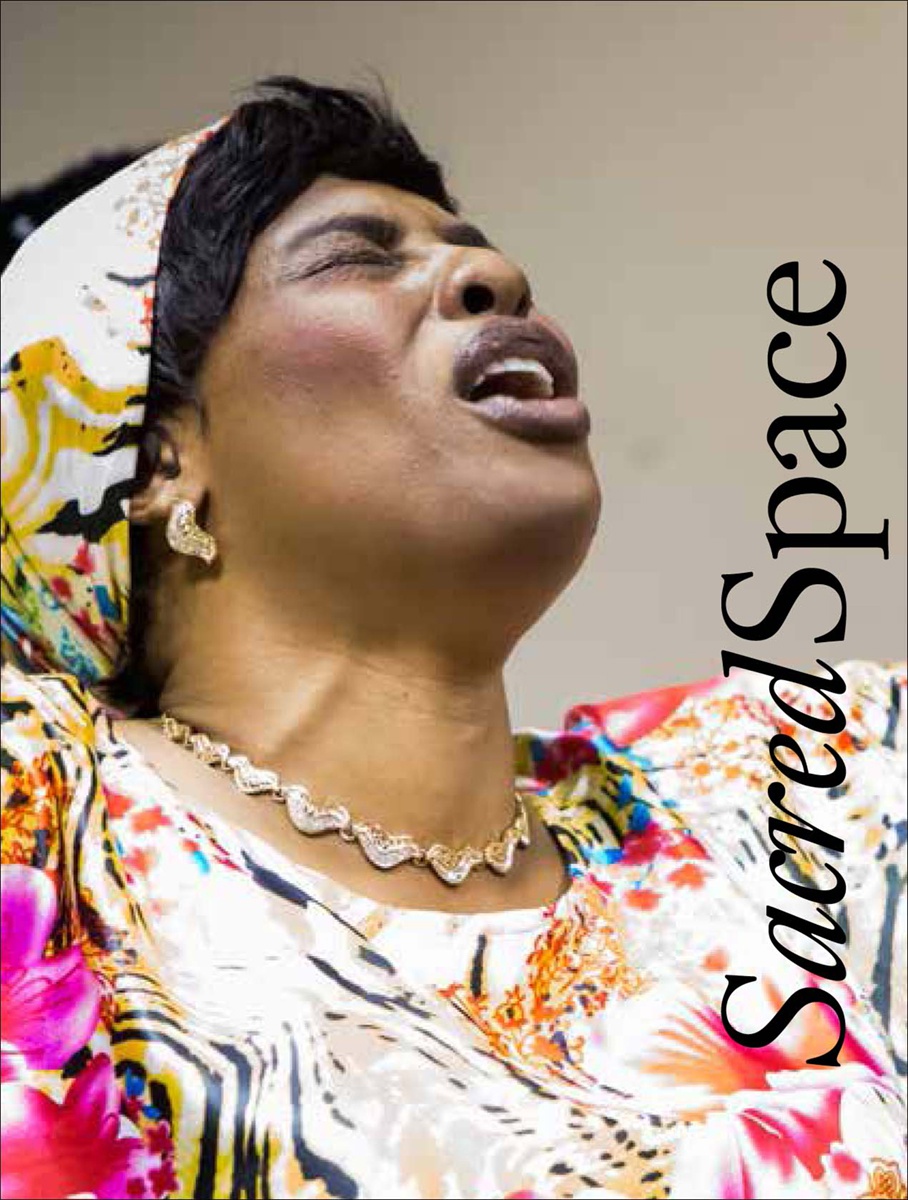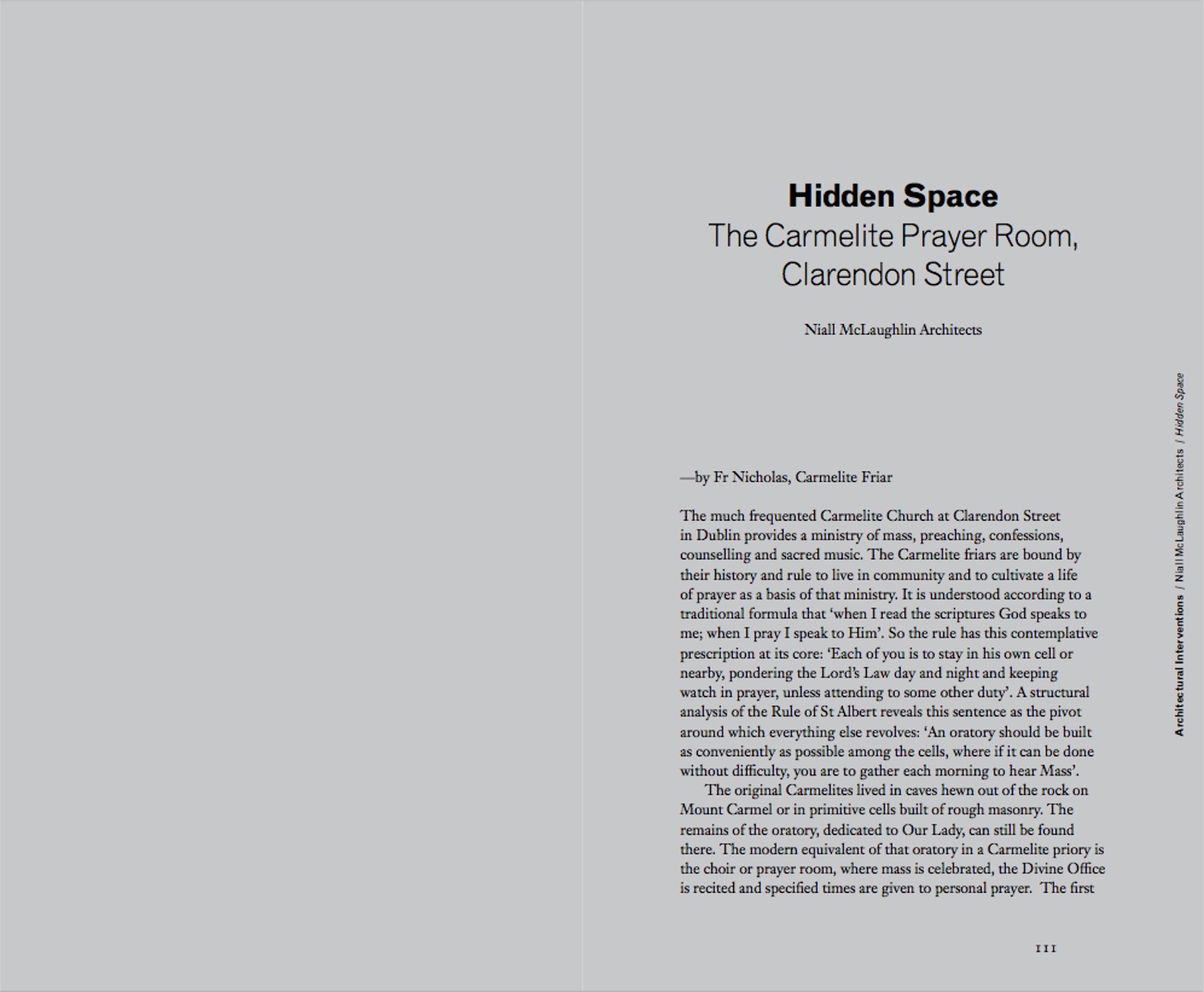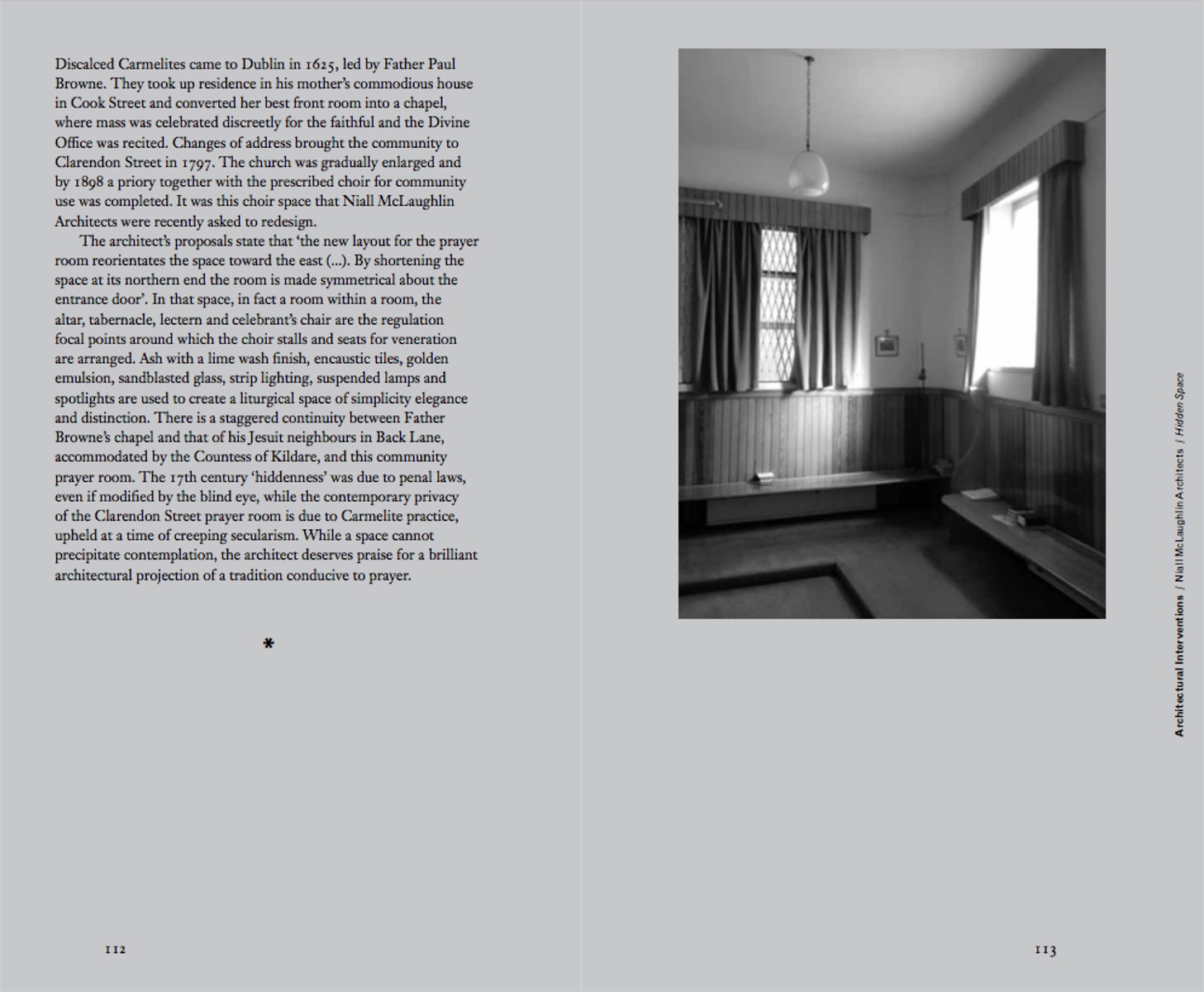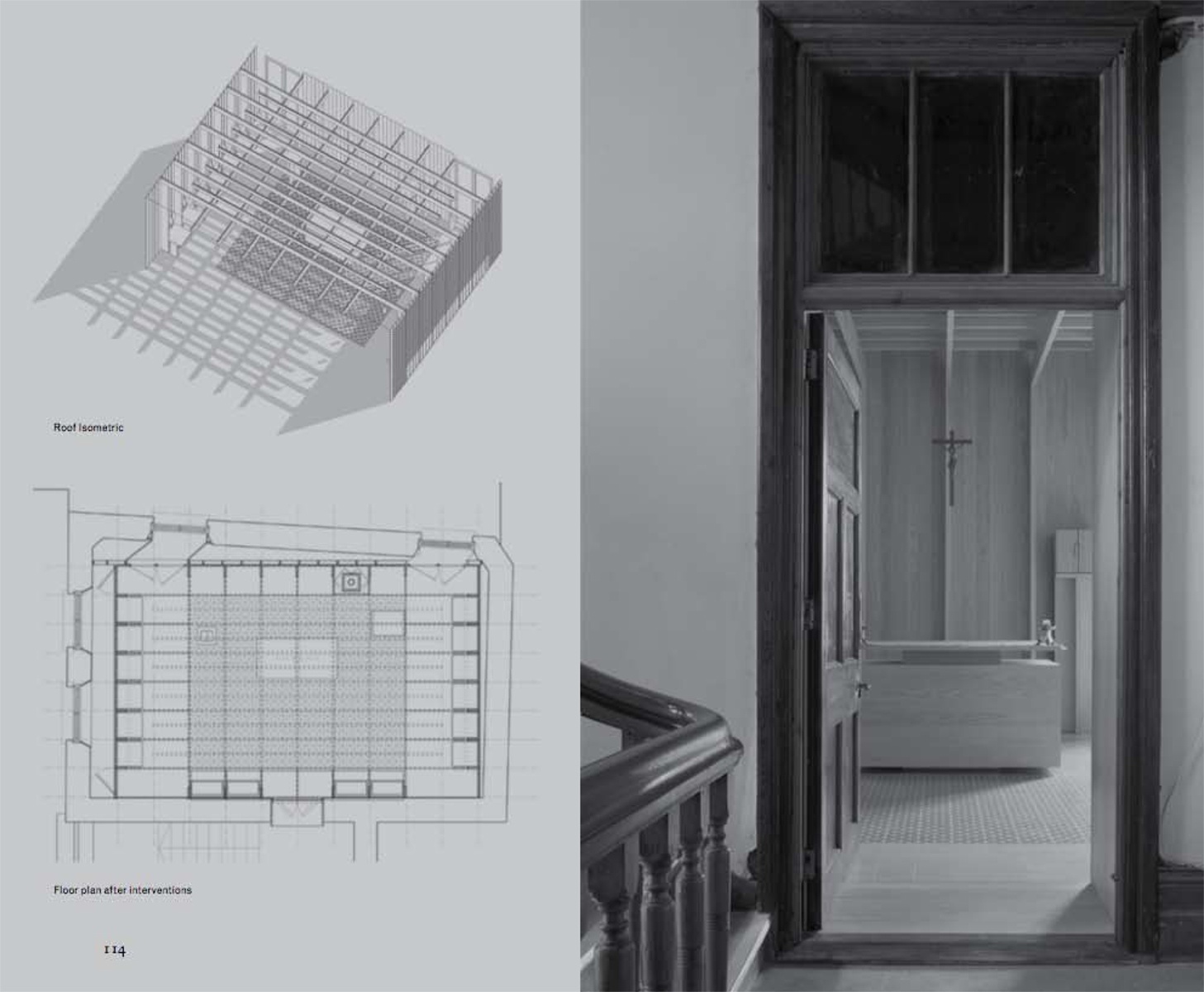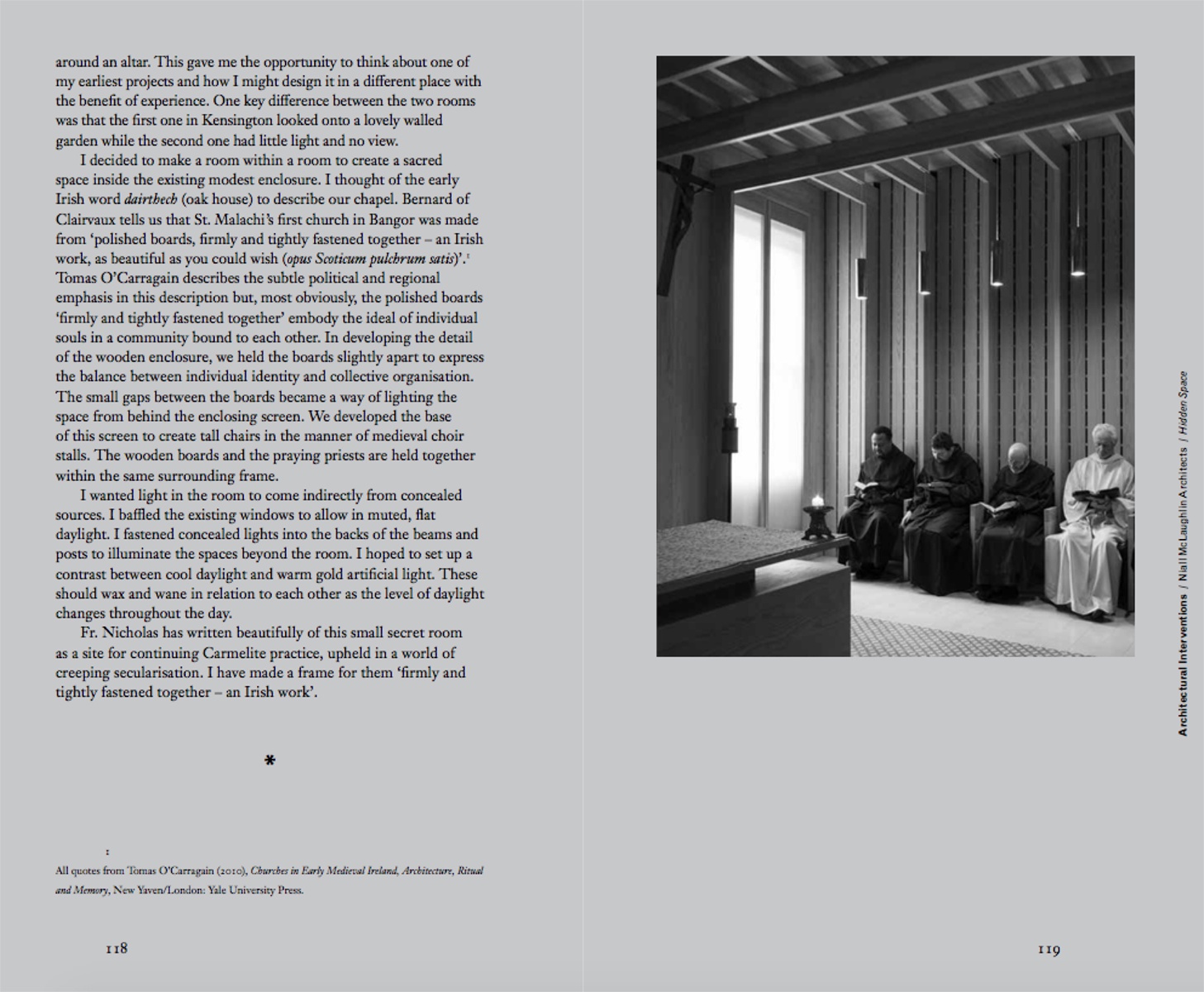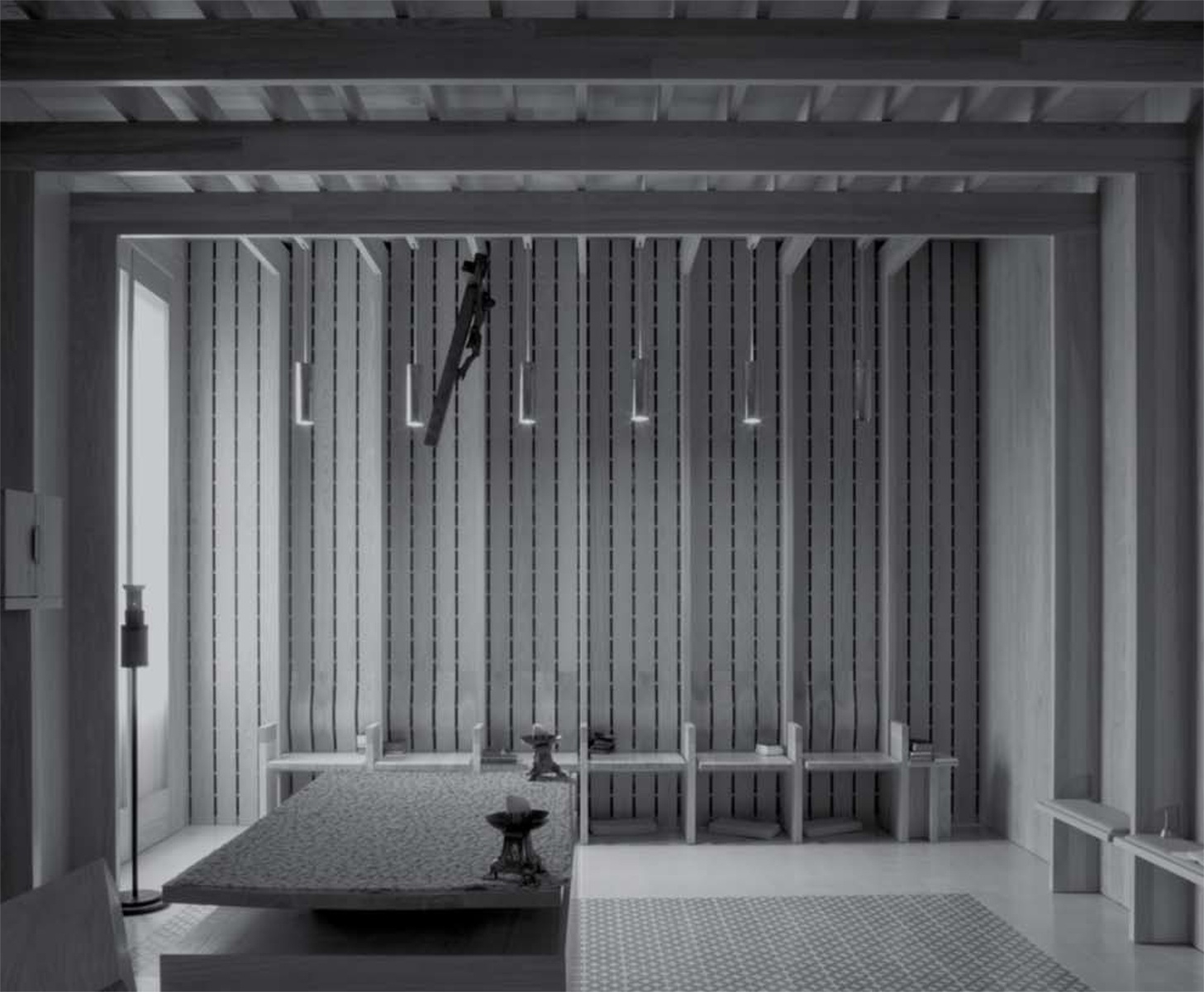Sacred Spaces
Carmelite Chapel, Dublin
Published by Darc Spaces for the Sacred Spaces Exhibition
HIDDEN SPACE
ESSAY BY Fr Nicholas, Carmelite Friar
The much frequented Carmelite Church at Clarendon Street in Dublin provides a ministry of mass, preaching, confessions, counselling and sacred music. The Carmelite friars are bound by their history and rule to live in community and to cultivate a life of prayer as a basis of that ministry. It is understood according to a traditional formula that ‘when I read the scriptures God speaks to me; when I pray I speak to Him’. So the rule has this contemplative prescription at its core: ‘Each of you is to stay in his own cell or nearby, pondering the Lord’s Law day and night and keeping watch in prayer, unless attending to some other duty’. A structural analysis of the Rule of St Albert reveals this sentence as the pivot around which everything else revolves: ‘An oratory should be built as conveniently as possible among the cells, where if it can be done without difficulty, you are to gather each morning to hear Mass’.
The original Carmelites lived in caves hewn out of the rock on Mount Carmel or in primitive cells built of rough masonry. The remains of the oratory, dedicated to Our Lady, can still be found there. The modern equivalent of that oratory in a Carmelite priory is the choir or prayer room, where mass is celebrated, the Divine Office is recited and specified times are given to personal prayer. The first Discalced Carmelites came to Dublin in 1625, led by Father Paul Browne. They took up residence in his mother’s commodious house in Cook Street and converted her best front room into a chapel, where mass was celebrated discreetly for the faithful and the Divine Office was recited. Changes of address brought the community to Clarendon Street in 1797. The church was gradually enlarged and by 1898 a priory together with the prescribed choir for community use was completed. It was this choir space that Niall McLaughlin Architects were recently asked to redesign.
The architect’s proposals state that ‘the new layout for the prayer room reorientates the space toward the east (…). By shortening the space at its northern end the room is made symmetrical about the entrance door’. In that space, in fact a room within a room, the altar, tabernacle, lectern and celebrant’s chair are the regulation focal points around which the choir stalls and seats for veneration are arranged. Ash with a lime wash finish, encaustic tiles, golden emulsion, sandblasted glass, strip lighting, suspended lamps and spotlights are used to create a liturgical space of simplicity elegance and distinction. There is a staggered continuity between Father Browne’s chapel and that of his Jesuit neighbours in Back Lane, accommodated by the Countess of Kildare, and this community prayer room. The 17th century ‘hiddenness’ was due to penal laws, even if modified by the blind eye, while the contemporary privacy of the Clarendon Street prayer room is due to Carmelite practice, upheld at a time of creeping secularism. While a space cannot precipitate contemplation, the architect deserves praise for a brilliant architectural projection of a tradition conducive to prayer.
An Irish Work —by Niall McLaughlin
In 1992, just as I was starting my practice in London, I was asked to design a small prayer room for the Carmelites in Kensington. I made a little square oratory, centred on the altar with twelve chairs gathered around the perimeter of the room. The backs of the chairs were elongated to extend the scale of the seated figures and to permanently suggest twelve presences around the central table; a reference to the Last Supper where Jesus gathered in a room with his disciples. Most of that community have now passed away, but I continued to receive comments and letters from priests who had visited this chapel over the next twenty years. When we were asked to design a prayer room in Clarendon Street in Dublin for the Carmelite Community, many of them had visited and prayed in this earlier project. So, it was the natural starting point for our conversations.
The upstairs room that was suggested for the project was hidden behind the apse of the St Theresa’s church. It had a rather unprepossessing aspect. It was dimly lit from windows that looked out over the back of Brown Thomas department store. The shape of the room was a long, rather irregular rectangle. There was a good door into it from a handsome staircase. In discussion with the priests, we decided once again to create a square surrounded by twelve tall chairs around an altar. This gave me the opportunity to think about one of my earliest projects and how I might design it in a different place with the benefit of experience. One key difference between the two rooms was that the first one in Kensington looked onto a lovely walled garden while the second one had little light and no view.
I decided to make a room within a room to create a sacred space inside the existing modest enclosure. I thought of the early Irish word dairthech (oak house) to describe our chapel. Bernard of Clairvaux tells us that St. Malachi’s first church in Bangor was made from ‘polished boards, firmly and tightly fastened together – an Irish work, as beautiful as you could wish (opus Scoticum pulchrum satis)’.1 Tomas O’Carragain describes the subtle political and regional emphasis in this description but, most obviously, the polished boards ‘firmly and tightly fastened together’ embody the ideal of individual souls in a community bound to each other. In developing the detail of the wooden enclosure, we held the boards slightly apart to express the balance between individual identity and collective organisation. The small gaps between the boards became a way of lighting the space from behind the enclosing screen. We developed the base of this screen to create tall chairs in the manner of medieval choir stalls. The wooden boards and the praying priests are held together within the same surrounding frame.
I wanted light in the room to come indirectly from concealed sources. I baffled the existing windows to allow in muted, flat daylight. I fastened concealed lights into the backs of the beams and posts to illuminate the spaces beyond the room. I hoped to set up a contrast between cool daylight and warm gold artificial light. These should wax and wane in relation to each other as the level of daylight changes throughout the day.
Fr. Nicholas has written beautifully of this small secret room as a site for continuing Carmelite practice, upheld in a world of creeping secularisation. I have made a frame for them ‘firmly and tightly fastened together – an Irish work’.
The project was initiated and delivered by Darc Space and recieved funding under the Governmant Policy of Architecture, 2009-2015
All quotes from Tomas O’Carragain (2010), Churches in Early Medieval Ireland, Architecture, Ritual and Memory, New Yaven/London: Yale University Press.
